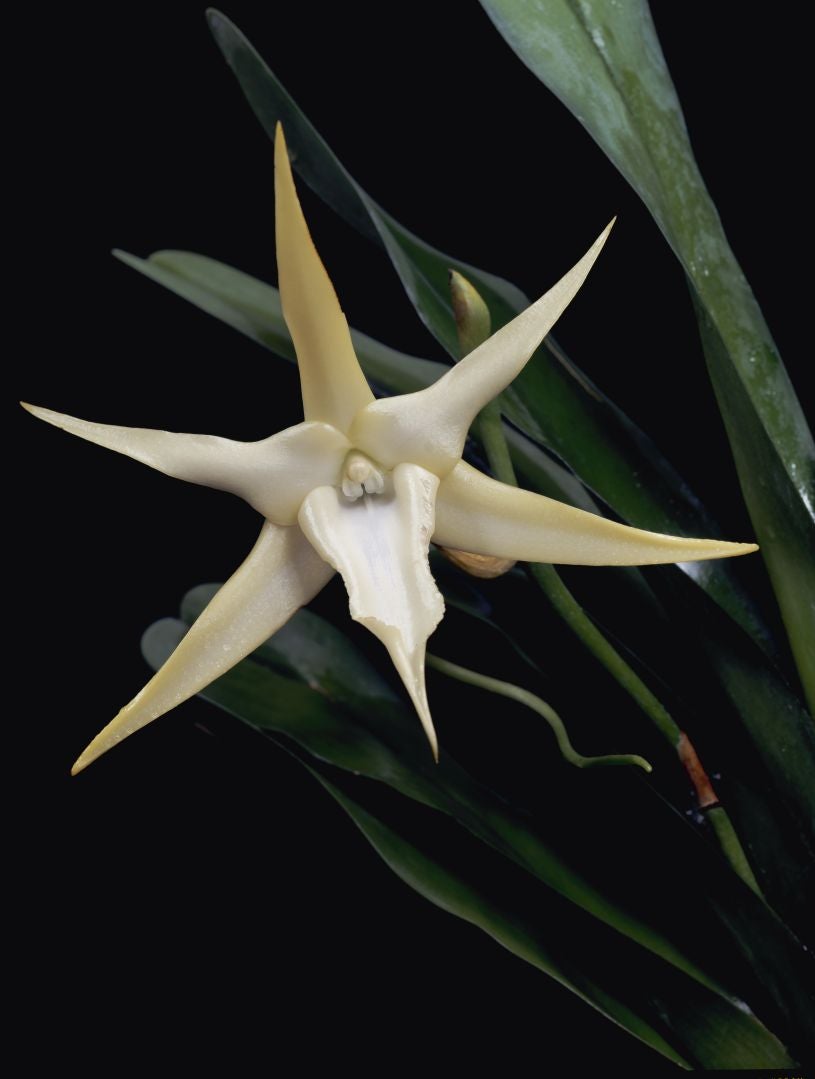Nature Studies: The Madagascar orchid and the extraordinary moth that goes with it

Yesterday at the Royal Botanic Gardens, Kew, I saw a flower which has recently gone on show and which is doubly notable, firstly for its beauty, and secondly, for the story that goes with it. It is a wild orchid, a spectacular six-pointed white star from Madagascar, and in its display case in Kew’s Princess of Wales Conservatory, the label gives no information about it whatsoever, other than its scientific name: Angraecum sesquipedale.
But in English it is often called Darwin’s orchid, and thereby hangs the tale: for when Charles Darwin was sent an example of this flower in 1862, not long after publishing The Origin of Species and launching his theory of evolution on an astonished world, he took one look at it and made an extraordinary prediction, which, more than 40 years later, turned out to be accurate.
Darwin saw that hanging down behind the big, waxy-white flower petals was a thin green tube nearly a foot long which was the nectary, the receptacle holding in its bottom the flower’s nectar – the sugary substance produced as an inducement for insects to visit the plant and so, accidentally, also take away its pollen, which would then be transferred to other flowers and enable pollination to take place.
But this tube, the “spur” as it is formally known, was so long and thin and tight that nothing could possibly crawl down it, and Darwin wrote in wonder to his best friend, the botanist Joseph Hooker, later Kew’s director: “Good Heavens! What insect can suck it?”
However, he soon had a pretty good idea himself. Darwin was obsessed with how orchids, the world’s largest plant family with nearly 30,000 species, are pollinated by insects, because they had evolved a myriad different ways of bringing it about, and his next book after The Origin of Species was actually entitled The Various Contrivances By Which Orchids Are Fertilized By Insects: it is little-read today, but it is fascinating, if extremely technical (his botanical knowledge was encyclopaedic).
In it, Darwin predicted that somewhere in Madagascar's forests, a moth would have to exist with an enormous proboscis, or coiled tongue, eleven inches long – much, much longer than its body – which could get at the nectar at the bottom of the nectar spur of Angraecum sesquipedale, on the basis that the flower’s spur and the moth’s tongue would have to have evolved together.
No such moth was known to exist in Madagascar, and in some quarters, Darwin was ridiculed. But he was right. More than four decades later, in 1903, a population of the hawk moth Xanthopan morganii, commonly called Morgan's sphinx moth, was discovered in Madagascar, and it did indeed have a proboscis of the requisite staggering size. (The moth was originally named Xanthopan morganii praedicta, meaning this was the moth Darwin had predicted would exist, but the third name has now been dropped.)
For me, Kew putting Darwin’s orchid on display was quite an event (the RBG has about 8,000 orchids in its nurseries, of about 3,000 species, and only relatively few can be shown at any one time).
If you wish to go and see it in the Princess of Wales Conservatory, you can find it in a terracotta pot in the centre of the glass display case in Zone Six: Tropical Orchids. Perhaps you should hurry, as it’s starting to go over (although they might replace it with a new plant). But if you do see it, you may will marvel at the piece of evolution which is its nectar spur, co-evolved to be pollinated by a bizarre moth’s enormous tongue.
You might not even believe it happens. But in Madagascar in 2004 a tropical butterfly expert from the University of New Orleans, Professor Philip DeVries, managed, using an infra-red camera, to film the moth inserting its monstrous appendage into the orchid, in the dead of the night. You can find it on Youtube, and it’s one of the most remarkable pieces of wildlife footage you’ll ever see.
MIGRATING BIRDS MEANS SHOOTING SEASON IN MALTA
Something else worth looking at on Youtube: the series of video diaries the naturalist and TV presenter Chris Packham did last week from Malta, where the spring shooting season for migratory birds is in full swing, to the island’s shame. Malta is the only member state of the EU which allows spring migrants heading north to all of Europe to be shot, in this case turtle doves and quail, which is bad enough as quail are rare, and turtle doves, in Britain at least, are heading straight for extinction.
But the hunters bang away at anything that moves, as Chris Packham documented dramatically with filmed evidence of illegal killed species from little bittern to Montagu’s harrier, from swift to Scopoli's shearwater. Not least in his standing up to intimidation from overbearing Maltese hunters, it was a memorable case of bearing witness, and has substantially raised the profile of a major wildlife disgrace which the European Union needs to sort out. Hats off to him.
Twitter: @mjpmccarthy
Join our commenting forum
Join thought-provoking conversations, follow other Independent readers and see their replies
Comments